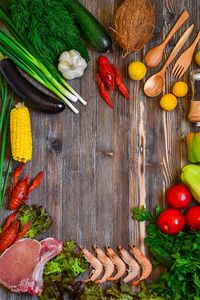How to Choose Fresh Ingredients for Cooking
 Tod Malicoat
19 Sep, 2025
12 mins read
7
Tod Malicoat
19 Sep, 2025
12 mins read
7

Cooking is an art, and like any masterpiece, it begins with the right materials. Fresh ingredients are the unsung heroes of a delicious meal. They not only enhance flavors but also add color and nutrition to your dishes. Whether you're whipping up a simple stir-fry or an elaborate feast, starting with fresh produce can elevate your culinary creations in ways you might not have imagined.
Imagine biting into a crisp vegetable that bursts with flavor or savoring succulent meat sourced from local farms. It’s about more than just taste; it's about experiencing food in its purest form. The journey to find these gems can be both exciting and rewarding, transforming routine cooking into an exploration of seasonal bounty.
Ready to learn how to choose the best fresh ingredients? Let’s dive into some essential tips and tricks that will help you make informed decisions at the market or grocery store—ensuring every dish you prepare reflects quality and freshness!
The Importance of Fresh Ingredients in Cooking
Fresh ingredients are the backbone of any great dish. They bring vibrant flavors that dried or processed alternatives simply can't replicate. When you use fresh produce, you're not just enhancing taste; you're also boosting nutrition.
The freshness factor impacts texture, too. A crisp cucumber or a tender piece of meat adds dimension to your meals. This variety creates an engaging eating experience that keeps everyone coming back for more.
Moreover, cooking with seasonal ingredients supports local farmers and reduces your carbon footprint. Knowing where your food comes from fosters a connection between you and your meal, turning cooking into a meaningful ritual rather than just another chore.
Incorporating fresh components encourages creativity in the kitchen as well. You might find inspiration in what’s available at the market each week, leading to delicious surprises on your plate!
Understanding Seasonality and Local Produce
Seasonality plays a crucial role in choosing fresh ingredients. When you cook with seasonal produce, you tap into nature’s rhythm. Each season brings its own bounty of fruits and vegetables, bursting with flavor.
Local produce is often fresher because it doesn’t spend long traveling from farm to table. This short supply chain means more nutrients and better taste. Think about juicy summer tomatoes or crisp autumn apples; they offer the best when harvested at their peak.
Visiting farmers' markets can be an exciting way to discover what’s in season nearby. Farmers are passionate about their crops, so ask them questions! They can share tips on how to prepare unfamiliar items.
Understanding which ingredients thrive during specific times of the year enhances your culinary experience while supporting local agriculture. Embrace this knowledge for flavorful meals that celebrate the seasons!
Tips for Choosing Fresh Fruits and Vegetables
When selecting fresh fruits and vegetables, look for vibrant colors. Bright hues indicate ripeness and nutritional value.
Feel the texture too. A firm apple or a plump tomato often means freshness. If they’re mushy or dull, it might be time to pass.
Check for blemishes as well. Minor imperfections can mean something was stored poorly, affecting taste and quality.
Smell plays a crucial role too. Ripe fruits usually emit sweet aromas that signal readiness for your kitchen.
Don’t shy away from seasonal options—they tend to be fresher and more flavorful. Visit local farmers' markets when possible; you’ll discover unique varieties you don’t find in stores.
Ask questions! Farmers are passionate about their produce and can offer valuable insights into what’s best at the moment. Engaging with them enhances not just your experience but also your understanding of food sourcing.
How to Select Quality Meats and Seafood
When it comes to selecting quality meats and seafood, appearance is key. Look for vibrant colors in both meat and fish. Fresh beef should have a bright red hue, while pork can range from pink to pale red. Fish should be clear and shiny, with no dullness.
Texture matters too. Gently press your finger into the meat; it should bounce back without leaving an indentation. For fish, fresh fillets feel firm yet pliable.
Smell plays a significant role as well. Fresh seafood has a clean ocean scent, not a strong or sour odor that indicates spoilage.
Don’t shy away from asking questions at the butcher counter or seafood market. Inquire about sourcing practices and whether they offer sustainable options.
Pay attention to packaging dates if buying pre-packaged items—fresh products typically have the furthest expiration dates available.
The Role of Herbs and Spices in Adding Flavor
Herbs and spices are the unsung heroes of cooking. They transform ordinary dishes into extraordinary experiences. A pinch of basil can elevate a simple tomato sauce, while cumin adds warmth to stews.
Fresh herbs like cilantro or parsley brighten flavors, bringing a burst of freshness to your meals. Dried spices, on the other hand, offer depth and complexity that enhances the overall taste profile.
Experimenting with different combinations allows for creativity in the kitchen. Don’t shy away from bold choices; try adding smoked paprika for a kick or turmeric for color and health benefits.
Remember that quality matters. Freshly ground spices boast more robust flavors than their pre-ground counterparts. Keep an eye out for vibrant colors—this indicates freshness and potency.
Using herbs and spices not only adds flavor but also reduces reliance on salt or sugar, promoting healthier eating habits without sacrificing taste.
Locally Sourced vs. Store-bought Ingredients
When it comes to cooking, the source of your ingredients can significantly impact flavor and quality. Locally sourced items often boast superior freshness. Farmers' markets and local producers typically harvest their goods at peak ripeness, ensuring vibrant taste.
On the other hand, store-bought ingredients offer convenience. They provide a wider selection year-round, making them accessible regardless of seasonality. However, they might lack that same farm-to-table vibrancy.
Choosing between these options depends on what you value more: sustainability or availability? Eating locally supports community economies and reduces carbon footprints. Yet sometimes a quick trip to the grocery store is just what you need after a long day.
Experimenting with both can lead to delightful discoveries in your kitchen! Try sourcing seasonal produce while keeping staples from the store for balance in your meals. Each choice contributes uniquely to your culinary adventure.
Conclusion: Embracing the Benefits of Cooking with Fresh Ingredients
Cooking with fresh ingredients transforms any meal into a delightful experience. The vibrant colors and natural aromas invite creativity in the kitchen.
When you choose quality produce, meats, and herbs, you're not just enhancing flavor; you're also nourishing your body. Fresh ingredients are packed with nutrients that support overall health and well-being.
Experimenting with seasonal items can lead to exciting new dishes. You might discover local treasures at farmers' markets or community gardens that inspire unique recipes.
Embracing freshness encourages sustainability too. Supporting local farmers reduces your carbon footprint while contributing to the economy.
Cooking becomes more than a chore—it's an enjoyable journey of discovery that connects you to food sources. By prioritizing fresh ingredients, every meal is an opportunity to create something special.
FAQs
What are the signs of fresh produce?
Fresh fruits and vegetables should be vibrant in color, firm to the touch, and free from blemishes. Look for produce that feels heavy for its size; this often indicates juiciness.
How can I tell if meat is fresh?
Fresh meat should have a bright color without any gray or brown spots. It should also have a clean smell—not sour or off-putting. Additionally, check for firmness; it shouldn't feel slimy.
Why is seasonal cooking important?
Cooking with seasonal ingredients ensures that you’re using products at their peak flavor and nutritional value. Seasonal items tend to be more affordable as well since they are abundant during their harvest times.
Are organic ingredients worth the investment?
Organic ingredients often have higher quality because they are grown without synthetic pesticides or fertilizers. While sometimes pricier, many find the taste difference worthwhile.
Where can I find local producers near me?
Local farmers’ markets and community-supported agriculture (CSA) programs are excellent places to discover nearby producers. Many communities also host events showcasing local farms where you can purchase directly from growers.
Can herbs really enhance my dishes significantly?
Absolutely! Fresh herbs provide intense flavors that dried versions can't match. They add brightness and depth to your meals while offering numerous health benefits too.
Is there any difference between store-bought spices and those bought at specialty stores?
Yes, store-bought spices may not always guarantee freshness compared to those purchased at specialty shops or farmer's markets. Specialty stores often carry fresher options with stronger flavors due to quicker turnover rates.
Written By:
Tod Malicoat



Hotels at your convenience
Now choose your stay according to your preference. From finding a place for your dream destination or a mere weekend getaway to business accommodations or brief stay, we have got you covered. Explore hotels as per your mood.


